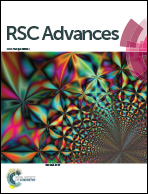Secondary metabolites with chemical diversity from the marine-derived fungus Pseudallescheria boydii F19-1 and their cytotoxic activity†
Abstract
Two aromadendrane-type sesquiterpene diastereomers pseuboydones A, B (1, 2), two diketopiperazines pseuboydones C, D (3, 4), and a cyclopiazonic acid analogue pseuboydone E (13) together with twenty known compounds (5–12, 14–25) were isolated from the culture broth of the marine-derived fungus associated with the soft coral Lobophytum crassum. The twenty-five compounds in total belong to diverse structural classes, including sesquiterpenoids, diketopiperazines, alkaloids, meroterpenoids, pyrazines, and polyketides. The structures of the new compounds were elucidated using HRMS, 1D and 2D NMR spectroscopic data, ECD calculations, and X-ray single crystal diffraction analysis. Compounds 3, 11, 16, 17, and 18 displayed significant cytotoxicity against the Sf9 cells from the fall armyworm Spodoptera frugiperda.


 Please wait while we load your content...
Please wait while we load your content...